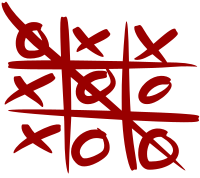Silang-bulat-silang
Tic-tac-toe (also known as noughts and crosses or Xs and Os) is a paper-and-pencil game for two players, X and O, who take turns marking the spaces in a 3×3 grid. The player who succeeds in placing three of their marks in a horizontal, vertical, or diagonal row wins the game.
 A completed game of Tic-tac-toe | |
| Genre | Paper-and-pencil game |
|---|---|
| Jumlah pemain | 2 |
| Waktu persiapan | Minimal |
| Waktu permainan | ~1 minute |
| Kesempatan acak | None |
| Keterampilan yang dibutuhkan | Strategy, tactics, observation |
| Sinonim | Noughts and crosses Xs and Os |
The following example game is won by the first player, X:

Players soon discover that the best play from both parties leads to a draw. Hence, tic-tac-toe is most often played by young children.
Because of the simplicity of tic-tac-toe, it is often used as a pedagogical tool for teaching the concepts of good sportsmanship and the branch of artificial intelligence that deals with the searching of game trees. It is straightforward to write a computer program to play tic-tac-toe perfectly or to enumerate the 765 essentially different positions (the state space complexity) or the 26,830 possible games up to rotations and reflections (the game tree complexity) on this space.[1]
The game can be generalized to an m,n,k-game in which two players alternate placing stones of their own color on an m×n board, with the goal of getting k of their own color in a row. Tic-tac-toe is the (3,3,3)-game.[2] Harary's generalized tic-tac-toe is an even broader generalization of tic-tac-toe. It can also be generalized as a nd game. Tic-tac-toe is the game where n equals 3 and d equals 2.[3] If played properly, the game will end in a draw, making tic-tac-toe a futile game.[4]
- ^ Schaefer, Steve (2002). "MathRec Solutions (Tic-Tac-Toe)". Diakses tanggal 2015-09-18.
- ^ Pham, Duc-Nghia; Park, Seong-Bae (2014-11-12). PRICAI 2014: Trends in Artificial Intelligence: 13th Pacific Rim International Conference on Artificial Intelligence, PRICAI 2014, Gold Coast, QLD, Australia, December 1-5, 2014, Proceedings (dalam bahasa Inggris). Springer. ISBN 9783319135601.
- ^ Golomb, Solomon; Hales, Alfred. "Hypercube Tic-Tac-Toe" (PDF). Diakses tanggal December 17, 2016.
- ^ W., Weisstein, Eric. "Tic-Tac-Toe". mathworld.wolfram.com (dalam bahasa Inggris). Diakses tanggal 2017-05-12.